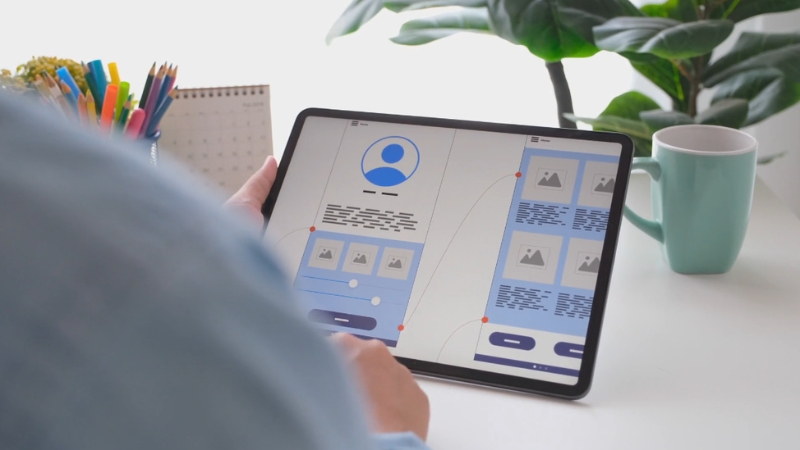Technology in the 21st century is evolving faster than ever, and people want the best of it—without wasting a second. Whether it’s browsing a website or using a mobile app, users expect everything to be lightning-fast and effortless.
The moment a page lags or an app is slow to open, frustration kicks in, and chances are, users will abandon it altogether.
For brands and businesses, that’s a serious problem.
A slow or poorly designed digital experience can hurt your reputation, derail your marketing efforts, and cut into your revenue.
That’s why UI/UX design isn’t just a nice-to-have—it’s essential. A thoughtful, user-focused design can make all the difference.
Here are some key benefits UI/UX design brings to businesses today:
1. Enhances Customer Acquisition
Customer acquisition is all about bringing new people into your business—convincing them that your product or service is worth their time and money. It’s a critical part of growth, and companies often measure it through customer acquisition cost (CAC), which helps evaluate how much value each new customer brings.
There’s no one-size-fits-all approach to attracting new customers, but one key factor that’s often overlooked is user experience (UX). A great UI/UX design can be a game-changer when it comes to standing out in a crowded market.
A visually appealing, easy-to-navigate website or app helps establish trust and makes potential customers more likely to stick around—and ultimately convert. When a digital product feels smooth, intuitive, and thoughtfully designed, it often does more to win over customers than pricing alone.
In short, a strong UI/UX doesn’t just make things look good—it actively drives growth by improving how users experience your brand from the first click.
2. Boosts Customer Retention
Just like acquiring new customers, keeping them around—aka customer retention—takes strategy and thoughtful planning. While customer acquisition lays the groundwork, it’s retention that builds long-term relationships and maximizes the lifetime value of each user.
Businesses need to invest just as much effort in keeping their existing customers happy as they do in attracting new ones. After all, it’s often more cost-effective to retain a customer than to find a new one. This is where great UI/UX comes into play.
An application or website that’s visually appealing, simple to navigate, and genuinely enjoyable to use keeps users coming back. Think about a mobile shopping app that not only looks great but also makes browsing and ordering a breeze—users will naturally want to stick with it.
When the experience is smooth and engaging, customers are more likely to stay loyal, make repeat purchases, and even become advocates for the brand.
Even if people aren’t looking to purchase, if browsing is easy, they’re more likely to pick and purchase items they like.
3. Saves Time and Cuts Development Costs

Everyone can recognize a well-designed app or website—it just works. On the other hand, poor design is just as easy to spot.
Apps that crash often, feel outdated or are riddled with bugs are frustrating to use.
The same goes for websites that are hard to navigate, have clashing color schemes, or awkward typography—users won’t stick around for long.
That’s why investing in quality UI/UX design from the start is crucial. By working with a professional design team or agency, businesses can build intuitive, visually appealing, and efficient digital experiences that not only meet user expectations but also streamline the development process.
When UI/UX is baked into development early on, it helps identify and fix usability issues before they become expensive problems.
Designers can anticipate user needs, ensure a smooth experience, and create scalable solutions that grow with the audience.
This proactive approach not only improves user satisfaction but also saves valuable time and resources down the line—avoiding costly redesigns or endless patches after launch.
4. Increases Employee Productivity

In today’s digital-first world, most businesses rely on user interfaces—not just for customers, but for their internal teams too. A well-designed, cohesive UI/UX doesn’t just help sell products or services; it also plays a major role in motivating employees and enhancing workplace efficiency.
When employees are stuck using outdated, clunky systems, it can drain their energy and impact productivity. On the other hand, a clean, intuitive interface makes it easier for them to navigate tools, access important information, and get their work done faster.
Good UI/UX design streamlines layouts organizes menus more effectively, and removes unnecessary friction in day-to-day tasks.
5. Drives Higher User Engagement
View this post on Instagram
More than just goals, funnels, or calls-to-action, the real test of a website or app’s effectiveness is engagement. If users aren’t interacting with your platform, the rest of your strategy doesn’t matter much. That’s why UI/UX design should always prioritize engaging users from the moment they land on a page.
You’ve only got a few seconds to make a good impression—about 3 seconds to show visitors they’re in the right place, and roughly 30 seconds to capture their interest enough to keep them exploring. That’s where thoughtful, user-focused design comes in.
Good UI/UX guides users smoothly through a journey, encouraging them to take the next step—whether it’s reading more, signing up, or making a purchase.
Every page should have a purpose and clearly communicate what action the user should take next. While calls-to-action are important, true engagement goes beyond that.
The entire site should feel intuitive and goal-driven, with design choices that support clarity over complexity.
One key tip? Be direct. A site that’s clear about its purpose and easy to navigate will always outperform one that’s overly flashy but confusing. Great design doesn’t just look good—it makes users feel confident and comfortable as they interact with your brand.
For instance, using soft color palettes and highlighting key content helps employees spot critical information at a glance—keeping distractions to a minimum and their attention where it matters most.
In short, great UI/UX doesn’t just benefit customers—it empowers the people behind the scenes, too.
The Bottom Line
@pixeldesignlab How I became UX/UI designer after 6 months without design degree 👉🏼 I’m a self taught designer who got first job just after 6 months since my first UX design course, and after 2 years I decided to leave my fulltime job and start my own design business and you can too! Story time! ✨ #uxdesigner #uxuidesigner #uxdesign #uxdesigntips #uxdesignerlife #designer #designjourney #howtodesign #appdesign #mobileapps #webdesigner #productdesign #productdesigner #storytime ♬ original sound – Vero👩🏽💻UX+Brand Designer
At the end of the day, great UI/UX design isn’t just about making things look nice—it’s about creating real value for both users and businesses. From attracting new customers and keeping them loyal, to saving development costs and boosting internal productivity, a strong design strategy has a ripple effect across every part of an organization.
In a digital world where attention spans are short and expectations are high, the brands that succeed are the ones that prioritize the user experience. Whether it’s through a beautifully designed app or a seamless website interface, the way people interact with your product can make—or break—their relationship with your brand.
Investing in thoughtful, user-centric design isn’t just smart—it’s essential for growth, engagement, and long-term success.

